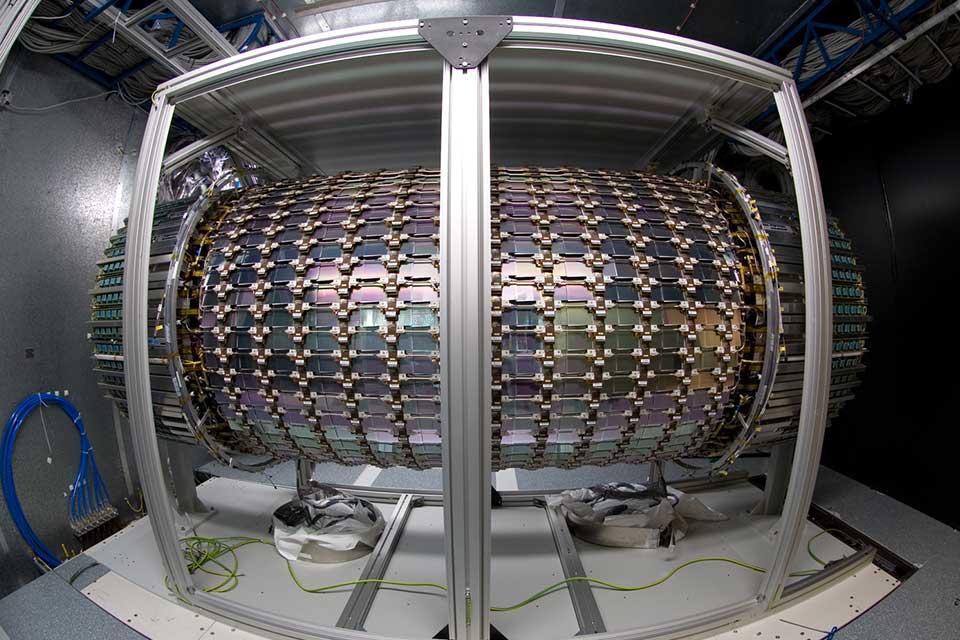Scientists from Oxford University are among the thousands of researchers worldwide honoured with the 2025 Breakthrough Prize in Fundamental Physics, awarded to the ATLAS Collaboration at CERN's Large Hadron Collider (LHC) alongside its sister experiments ALICE, CMS and LHCb.
ATLAS is one of the largest and most complex scientific instruments ever built. As a general-purpose particle detector measuring over 40 metres in length and around 25 metres in height, it was designed to investigate the fundamental building blocks of matter and the forces governing our universe. Its cutting-edge systems track particles produced in particle collisions at unprecedented energies, enabling discoveries like the Higgs boson and searches for new physics beyond the Standard Model.
The Breakthrough Prize specifically highlights the ATLAS Collaboration’s significant contributions to particle physics, including detailed measurements of Higgs boson properties, studies of rare processes and matter-antimatter asymmetry, and the exploration of nature under the most extreme conditions.
‘The Breakthrough Prize is a testament to the dedication and ingenuity of the ATLAS Collaboration and our colleagues across the LHC experiments,’ said ATLAS Spokesperson Stéphane Willocq. ‘This prize recognises the collective vision and monumental effort of thousands of ATLAS collaborators worldwide.’
‘I am extremely proud to see the extraordinary accomplishments of the LHC collaborations honoured with this prestigious Prize,’ said Fabiola Gianotti, Director-General of CERN. ‘It is a beautiful recognition of the collective efforts, dedication, competence and hard work of thousands of people from all over the world who contribute daily to pushing the boundaries of human knowledge.’
Oxford has been at the forefront of ATLAS research since the start of the collaboration in 1992, contributing to:
- Construction and operation of the Semiconductor tracker (SCT) critical for all ATLAS Physics analysis, including the discovery and detailed study of the Higgs boson. The barrel section of the SCT was assembled and tested in Oxford before being sent to CERN.
- Analysis of Higgs-boson decays to W bosons. The work was included in the paper announcing its discovery in 2012, and Oxford physicists implemented further improvements over the subsequent decade.
- Development of machine learning techniques for analyzing and collecting data. This enabled the group to be leaders in the discovery of the Higgs-boson decays to b-quarks. The group also made major contributions to precision measurements of Higgs-boson decays to tau leptons and to searches for its decays to muons and charm quarks.
- Di-Higgs searches, as leaders of two major decay channels. Multi-Higgs events are key predictions of the Higgs mechanism that gives mass to elementary particles. Oxford also led the first-ever search for triple Higgs production.
- The ongoing SCT project, whose leader is an Oxford physicist. This role is critical to maintaining excellent data quality in the very harsh LHC environment.
- The upgraded silicon tracker (ITK), for which Oxford holds Leadership roles and coordinates the collaboration effort for the end cap pixel detector and all the mechanics and services (such as cooling and structural supports) for the central silicon strip tracker.
‘Our team's work on the many aspects of Higgs boson physics and the ITK upgraded tracker exemplifies the innovation driving ATLAS forward,’ said Professor Daniela Bortoletto, Head of Particle Physics at Oxford University. ‘This recognition affirms the impact of our contributions and inspires us to continue exploring the universe’s most fundamental questions.’
‘The successes of Run 2 showcase the ingenuity of the ATLAS Collaboration — not only in collecting data with a detector of outstanding precision, but also in our relentless drive to improve our understanding of it,’ said Andreas Hoecker, former ATLAS Spokesperson.
While the ATLAS Collaboration celebrates the recognition of the Breakthrough Prize, its focus remains firmly on the future. The third operation period of the LHC is currently underway and preparations for the High-Luminosity LHC upgrade are advancing rapidly. Oxford's team of 5 physicists and 8 engineers is deeply involved in preparing ATLAS for its next chapter. They are leading the development of the support and services for the upgrade strip and pixel detectors for the High-Luminosity LHC, which will increase collision rates tenfold when it begins operation in 2030.
‘We are now preparing the ATLAS detectors of the future — designed to harness these unprecedented data sets and further push our understanding of the universe’s fundamental building blocks,’ concludes Willocq.

